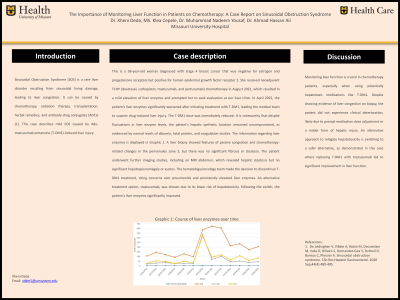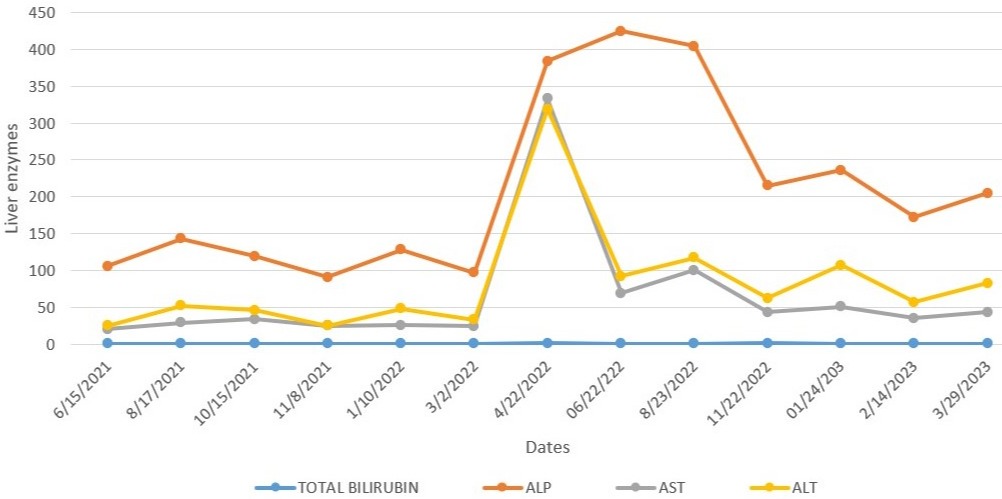Sunday Poster Session
Category: Liver
P1035 - The Importance of Monitoring Liver Function in Chemotherapy Patients: A Case Report on Sinusoidal Obstruction Syndrome
Sunday, October 22, 2023
3:30 PM - 7:00 PM PT
Location: Exhibit Hall

Has Audio
- XD
Xheni Deda, MD
Missouri University Hospital
Columbia, MO
Presenting Author(s)
Xheni Deda, MD1, Klea Cepele, MS2, Muhammad Nadeem. Yousaf, MD3, Ahmad Ali, MD1
1Missouri University Hospital, Columbia, MO; 2University of Missouri, Columbia, MO; 3University of Missouri-Columbia, Columbia, MO
Introduction: Sinusoidal Obstruction Syndrome (SOS) is a rare liver disorder resulting from sinusoidal lining damage, leading to liver congestion. It can be caused by chemotherapy, radiation therapy, transplantation, herbal remedies, and antibody-drug conjugates (ADCs). This case describes mild SOS caused by Ado-trastuzumab emtansine (T-DM1)-induced liver injury.
Case Description/Methods: This is a 58-year-old woman diagnosed with stage 4 breast cancer that was negative for estrogen and progesterone receptors but positive for human epidermal growth factor receptor 2. She received neoadjuvant TCHP (docetaxel, carboplatin, trastuzumab, and pertuzumab) chemotherapy in August 2021, which resulted in a mild elevation of liver enzymes and prompted her to seek evaluation at our liver clinic. In April 2022, the patient's liver enzymes significantly worsened after initiating treatment with T-DM1, leading the medical team to suspect drug-induced liver injury. The T-DM1 dose was immediately reduced. It is noteworthy that despite fluctuations in liver enzyme levels, the patient's hepatic synthetic function remained uncompromised, as evidenced by normal levels of albumin, total protein, and coagulation studies. The information regarding liver enzymes is displayed in Graphic 1. A liver biopsy showed features of passive congestion and chemotherapy-related changes in the perivenules zone 3, but there was no significant fibrosis or steatosis. The patient underwent further imaging studies, including an MRI abdomen, which revealed hepatic steatosis but no significant hepatosplenomegaly or ascites. The hematology/oncology team made the decision to discontinue T-DM1 treatment, citing concerns over pneumonitis and persistently elevated liver enzymes. An alternative treatment option, trastuzumab, was chosen due to its lower risk of hepatotoxicity. Following the switch, the patient's liver enzymes significantly improved.
Discussion: Monitoring liver function is crucial in chemotherapy patients, especially when using potentially hepatotoxic medications like T-DM1. Despite showing evidence of liver congestion on biopsy, the patient did not experience clinical deterioration, likely due to prompt medication dose adjustment or a milder form of hepatic injury. An alternative approach to mitigate hepatotoxicity is switching to a safer alternative, as demonstrated in this case where replacing T-DM1 with trastuzumab led to significant improvement in liver function.

Disclosures:
Xheni Deda, MD1, Klea Cepele, MS2, Muhammad Nadeem. Yousaf, MD3, Ahmad Ali, MD1. P1035 - The Importance of Monitoring Liver Function in Chemotherapy Patients: A Case Report on Sinusoidal Obstruction Syndrome, ACG 2023 Annual Scientific Meeting Abstracts. Vancouver, BC, Canada: American College of Gastroenterology.
1Missouri University Hospital, Columbia, MO; 2University of Missouri, Columbia, MO; 3University of Missouri-Columbia, Columbia, MO
Introduction: Sinusoidal Obstruction Syndrome (SOS) is a rare liver disorder resulting from sinusoidal lining damage, leading to liver congestion. It can be caused by chemotherapy, radiation therapy, transplantation, herbal remedies, and antibody-drug conjugates (ADCs). This case describes mild SOS caused by Ado-trastuzumab emtansine (T-DM1)-induced liver injury.
Case Description/Methods: This is a 58-year-old woman diagnosed with stage 4 breast cancer that was negative for estrogen and progesterone receptors but positive for human epidermal growth factor receptor 2. She received neoadjuvant TCHP (docetaxel, carboplatin, trastuzumab, and pertuzumab) chemotherapy in August 2021, which resulted in a mild elevation of liver enzymes and prompted her to seek evaluation at our liver clinic. In April 2022, the patient's liver enzymes significantly worsened after initiating treatment with T-DM1, leading the medical team to suspect drug-induced liver injury. The T-DM1 dose was immediately reduced. It is noteworthy that despite fluctuations in liver enzyme levels, the patient's hepatic synthetic function remained uncompromised, as evidenced by normal levels of albumin, total protein, and coagulation studies. The information regarding liver enzymes is displayed in Graphic 1. A liver biopsy showed features of passive congestion and chemotherapy-related changes in the perivenules zone 3, but there was no significant fibrosis or steatosis. The patient underwent further imaging studies, including an MRI abdomen, which revealed hepatic steatosis but no significant hepatosplenomegaly or ascites. The hematology/oncology team made the decision to discontinue T-DM1 treatment, citing concerns over pneumonitis and persistently elevated liver enzymes. An alternative treatment option, trastuzumab, was chosen due to its lower risk of hepatotoxicity. Following the switch, the patient's liver enzymes significantly improved.
Discussion: Monitoring liver function is crucial in chemotherapy patients, especially when using potentially hepatotoxic medications like T-DM1. Despite showing evidence of liver congestion on biopsy, the patient did not experience clinical deterioration, likely due to prompt medication dose adjustment or a milder form of hepatic injury. An alternative approach to mitigate hepatotoxicity is switching to a safer alternative, as demonstrated in this case where replacing T-DM1 with trastuzumab led to significant improvement in liver function.

Figure: Graphic 1: Course of liver enzymes over time
Disclosures:
Xheni Deda indicated no relevant financial relationships.
Klea Cepele indicated no relevant financial relationships.
Muhammad Yousaf indicated no relevant financial relationships.
Ahmad Ali indicated no relevant financial relationships.
Xheni Deda, MD1, Klea Cepele, MS2, Muhammad Nadeem. Yousaf, MD3, Ahmad Ali, MD1. P1035 - The Importance of Monitoring Liver Function in Chemotherapy Patients: A Case Report on Sinusoidal Obstruction Syndrome, ACG 2023 Annual Scientific Meeting Abstracts. Vancouver, BC, Canada: American College of Gastroenterology.
